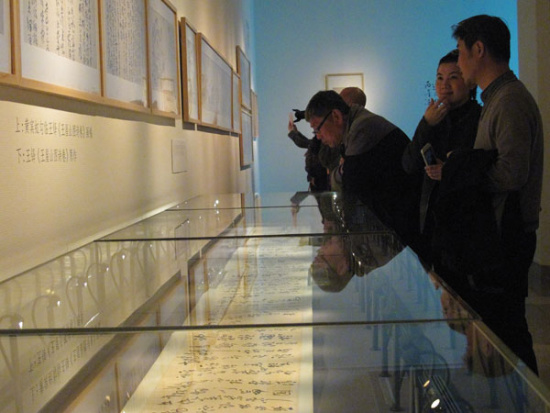
Visitors at Huang's retrospective show at the National Art Museum of China.(Photo by Jiang Dong/China Daily)
"I painted the work as an experiment to localize oil painting, and to find a novel way to express the cultural power of Chinese art."
Huang's art did not start to become truly recognized until the 1980s. Even today, not many people dare to say they truly or fully understand his artistic versatility and spiritual world. Debates continue over whether Huang's flower-and-bird works equal his mountain-and-water pieces, and whether he is truly an able calligrapher.
"Huang lived in a time when Western painting was spreading to China while Chinese painting became hollow," says Xue Yongnian, a professor with the Central Academy of Fine Arts. "Many painters were constrained by the traditional teachings; they spent most of the time copying masters' works but hesitated to proceed."
Among those who managed to make breakthroughs, one group-many of them studied art in Europe and Japan-combined the Western and Eastern techniques together, such as Xu Beihong, Liu Haishu and Lin Fengmian. The other group was heralded by Huang and Qi Baishi, considered two greats of Chinese painting in the 20th century. Both took over from the past and set a new course for the future.
"To better understand Huang, one should not forget his vicissitudes. Huang was at first an intellectual, an art theorist, then a painter," Xue says.
Common wisdom has it that it was Huang's passionate engagement with social affairs that prompted his gradual reforms in art. Huang, sensing the end of the feudal dynasties, gave up the keju imperial examinations. He admired and met Tan Sitong (1865-1898), the thinker who played a significant role in the Hundred Days' Reform in 1898; he was deeply influenced by Tan's reformist passion.
Huang advocated for building railways in his native Anhui province, and he supported local revolutionary activities. After moving to Shanghai, he edited and co-funded art magazines, a popular gesture to embrace reforms at the time. His intellectual vision nourished his artistic works.
"Huang didn't feel contented painting the scenery before his eyes. He sought to present under his strokes the 'great beauty of heaven and earth', the soul of people and how his spirit interacted with nature," Xue says.
Another retrospective show of Huang's art is underway at the Zhejiang Provincial Museum, Hangzhou, and will run through May 18.
If you go
9 am-5 pm, through May 10.
National Art Museum of China, 1 Wusi Dajie, Dongcheng district, Beijing. 010-6400-1476.
















































